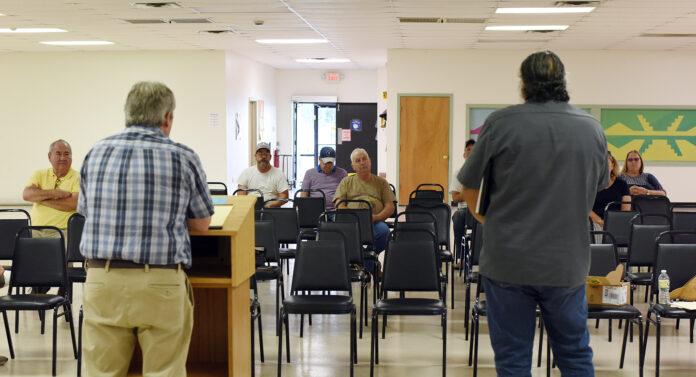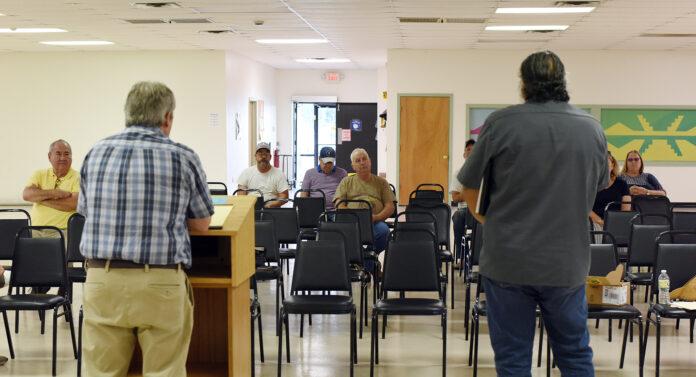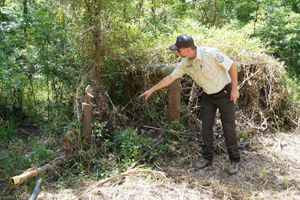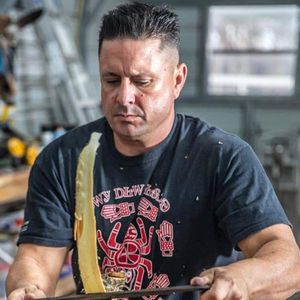
Using $3 million in ARPA funds, the Nation proposes building a new 293,000-gallon tank and new water lines for families and businesses west of Pawhuska
Written by Louise Red Corn
Allan Richards, a civil engineer with the Osage Nation’s water consulting firm, turned the tables at a meeting Aug. 22 to ask those who live west of Pawhuska a question.
“I’m having trouble understanding what you all do when you don’t have water for two weeks,” he said, as the 10 people in the audience chuckled.
“That’s not a sarcastic question. I just can’t imagine your water going off for that period of time.”

Principal Chief Geoffrey Standing Bear, whose home is frequently without water thanks to a confluence of issues with Osage County Rural Water District 21, piped up: “I had a pretty good discount rate over at the Black Gold Motel, but they sold it. Everybody just does what they can – [goes to] relatives. Everybody just tries to get by.”
The water crisis for about 50 homes and businesses west of Pawhuska is a four-fold nightmare. According to Richards, a longtime civil engineer with Stetson Engineering:
- RWD 21’s water source is at the Arkansas River near Newkirk, far too great a distance. Water has to travel about 40 miles to those unfortunate customers at the end of its line, which is clogged with “biofilm,” also known as slime or “biofouling” that occurs when bacteria and other microbes attach to the inner surfaces of water pipes;
- The 40-mile line is too skinny – three inches narrowing to two inches for the final 12 miles – to deliver water even when none of the biofilm is present; water works standards call for minimum of a 4-inch diameter line;
- The current storage tank or standpipe atop Timber Hill is in poor condition and holds little water; and
- The water quality is poor, with so much manganese, iron and other heavy metals that residents said they have to replace water heaters as often as every six months.
The Osage Nation has embarked on a plan to fix the problems using American Recovery Plan Act money because several Osage families are clustered on the end of RWD 21, including a family of seven, at least two cowboy families on the Osage Nation Ranch, and many others. Overall, RWD 21 serves about 1,500 customers, according to the Oklahoma Water Resources Board.
The short-term fix is to spend $3 million in ARPA funds to build a new water tank and an intermediate holding tank, two wells on Osage Nation land near Bird Creek and install pumps to get the water to those tanks. The first move would be to erect a new tank, about the same height but much larger than the current one, so that when RWD 21 actually has water flowing, it could be filled with about a week’s supply of water.

Stetson has identified two potential sites for a new 293,000-gallon tank, both at the high elevations in the area.
“One is in the chief’s backyard,” said Joe Ely, Richards’ colleague.
“That’s her backyard,” Chief Standing Bear said, gesturing to his wife, Julie. “I just live there.”
For the long-term fix, Stetson is proposing installing six-inch PVC water lines between the new wells and the towers, severing the current line from RWD 21 to create a new water district, and establishing a tie-in with the City of Pawhuska water system so, if either the city or the new district is stricken by an outage, either could draw water from the other.
Both Richards and Ely, who together have more than 70 years of experience with waterworks in Indian and non-Indian country, said they were astounded by the antiquated system those west of Pawhuska must rely upon.
“People having intermittent water delivery and sometimes no water at all,” Ely noted, “For us, that was a little difficult to understand how, in this century, that could happen.
“You have a big problem.”
Added Richards: “When I learned that the rural water district was delivering water 40 miles across the rangeland to the community out there through a three-inch pipe that then reduced to a two-inch pipe, I couldn’t believe it. I just couldn’t believe it.”
Some people who live in the area truck water in. Others rely on the kindness of relatives. Some have wells that they once used as back-up and now use constantly as RWD 21’s problems snowball.
“Last time it was out for a month, when we had the big freeze, I went back to well water,” said Marianne Schroeder, who ditched RWD 21 in 2021. “I won’t go back on the line yet because I keep hearing stories.
“And another thing about the rural water out there is that the quality of the water is not good. When I redid the house, we put in Culligan and my well water was better quality than the water from 21.”
Pawhuska Mayor Roger Taylor agreed with that assessment. Although he now lives on the other side of Pawhuska, he said he spent a year on RWD 21 and had to replace the heating element on his water heater three times. He added that the Assembly of God Church, another customer of RWD 21, is without hot water about every six months because the water destroys its heater.
Julie Standing Bear, the chief’s wife, interjected: “We actually sent ours to be tested a few years ago and it’s got all kinds of stuff in it.”
Reports from the Department of Environmental Quality show many water quality violations over the years, including recent violations of turbidity, disinfection byproducts, arsenic, nitrate, and monitoring standards.
Ely and Richards said that they hope to issue bid requests for the construction of a new storage tank in early 2023 and have it erected by the end of that same year. Test bores for the new wells near Bird Creek should begin soon, too – after which another public meeting will be held to discuss the results.
Federal money, Ely said, is abundant right now for such projects. The $3 million in ARPA money was initially earmarked for sewer and water projects in the Pawhuska Indian Village, but Craig Walker, an environmental specialist with the Nation’s Department of Environmental Resources, said that Indian Health Service should cover 100 percent of those costs, freeing up the money for the water project west of Pawhuska.

Congresswoman Paula Stabler asked if Congress would approve the change, said she was there to learn about it but did not foresee an issue as long as the village project stayed on track.
Dennis Severson, a resident of the RWD 21 area, said that $3 million seemed like a “chunk of change” for 50 families, and wondered if the money would have to be recouped somehow from water customers, but Ely disavowed him of that notion.
“This is money from the federal government that we all pay, when we get a paycheck and we see that little slice come out of there,” Ely said. “That’s what’s paying for it. There’s no illusions about it, it’s taxpayer money that’s paying for this whole thing, but once it comes to the nation those capital costs are not going to get paid back. The only cost is operation and maintenance.”
Said Craig Walker: “You’re already paying O and M on a line that’s breaking what, every other week?”
Ely said that the long-term project – which will cost at least $3 million just to lay 12 miles of 6-inch pipe – likely will be funded by a spending bill passed earlier this month:
“Whatever your politics may be, the horses are out of the barn and we’re going to try to catch one and bring it in and bring the money back here to a place that pays taxes like everybody else.
“You have a problem, and we don’t know how long funding is going to last, so we need to capture as much of it as we possibly can. We need to do it as quickly as we can but as responsibly as we can so that in the end you actually have a project that works and will last a long time.
“We’re walking as fast as we can. We’re not running. “
Ely’s colleague, Richards, shot him a glance and commented: “I’m running.”









